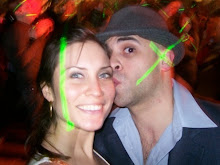Here it is! Since I am sure you've all been waiting for it, I give you my random Italian-related observation for the week:
I thought I'd throw onto the table the case of the Futurist movement, something McGann might have succesfully used in his "rationale" to corroborate his case for the necessity of electronic approaches to texts. Officially established in 1909 with the publication (first on Le Figaro, then in Italy) of Filippo Tommaso Marinetti's Futurist Manifesto, Futurism stemmed out the remnants of French decadentism and symbolism, and was densely infused with Nietzschian and Bergsonian ideas. With its myriad of manifestos (on painting, sculpture, music, architecture, and even gastronomy --which in my view are often far more interesting than the art works themselves) the movement laid the ground for the manifesto as a legitimate literary genre, and is today considered the founding father of all 20th century avant-gardes. During the second half of the 20th century, all around the world, but especially in Italy, Futurism was largely ignored, even stigmatized, in academic circles, mainly beacuse of its eventual artistic and political confluence into the Italian Fascist Party (before that, the Futurist Party had a brief political existence of its own). Only recently has the movement become object of serious scholarly inquiry, and its impact on all 20th century art (which cannot be overestimated) highlighted. While it would be impossible to recapitulate here the characteristics of this very complex movement, let it suffice to say that its premise was a complete re-thinking of the conditions of both production and fruition of works of art. The old "pastist" conception of art (in Marinetti's words, "dusty and nauseating"), which involved museums full of classicist statues, sentimental stories of love and loss, beautifully composed paintings and perfectly structured, tear-inducing plays--in short, all that appealed to the sensibility of the insufferable (at least for Marinetti) fin-de-siecle burgeousie--was completely rejected.
The bottom line--something I've become acutely aware of in these weeks, studying Marinetti's "literature" while tackling for the first time textual criticism and hyperediting-- is how completely inadequate the book form (a critical edition no less than a paperback with no notes) is in presenting any Futurist text. In fact, the book itself, with its static and linear quality, was seen as one the emblems of what had to be swept away from the planet (one Futurist even designed the "mechanical book"). Futurism existed in an ebullient, vibrant environment which involved every facet of life. Not only the different genres of literature, sculpture, painting, music, architecture, music, etc. Even what to eat (Marinetti despised pasta, the nauseatingly "pastist" backbone of Italian cuisine -- and the bad pun might not only be mine), what to wear, how to walk, how to talk and make love to women were critical aspects of every person's life that the Futurists wished to reconfigure. Marinetti (and others to lesser extents) made a point of "artisticizing", or "theatralizing" his own life, exploiting his extraordinary fame, and hoped to be making an artistic, poetic statement everytime he walked into a store, or drove through the streets of Milan. Never before had a single, unitary movement (not even the French revolution!) made such a radical attempt to redefine and revolutionize every facet of society (at least in theory). Needless to say, not even the best imaginable interactive, hypermedial, online resource site would be able to recapture the atmosphere that could be felt in Futurist circles or wherever Marinetti (known as "Europe's caffeine") stepped foot. But it could certainly help. At least we may be able to hear the unique style in which Marinetti and other futurist poets recited their works. We could view the performances of Futurist plays (either in the little original footage that survives or in the several "faithful" reenactments that have recently been staged). We would be able to quickly access the infinity of prints, the posters, the manuscripts that this movement produced. We could listen to futurist music and view the way it appeared on sheet (the traditional musical notation was also rejected, replaced by a new, futurist one). We could look at the plans for Russolo's "noise-makers" and the sketches for Futurist buildings that were never actually built. Ideally, we'd be able to also view all every product of Futurist painting and sculpture (although much of these are very famous, and the hypothetical archive might face copyright issues similar to those encountered by McGann). And more importantly, we would be able to move quickly (may I say instantaneously?) through all this material, thus at least partially glimpsing the sybiosis between the arts (and between art and life) that Futurism postulated.
2009 will mark the 100th anniversary of the Futurist movement, and a multitude of conferences, events, and reenactments of Furturist "happenings" are in the making. However, as of now, no site even vaguely similar to what I described exists. The best I could find is a page with links to 15-20 of the Manifestos (out of 100s and 100s...). I am including it below, together with other links (misleading and simplistic as they may be) that may provide you with a basic idea of what Futurism was.
the wikipedia page (as usual, questionable): http://en.wikipedia.org/wiki/Futurism
the "best" Futurism page I could find: http://www.unknown.nu/futurism/
futurist art (some of the main names are Boccioni, Balla, Depero, Carra`): http://www.artlex.com/ArtLex/f/futurism.html
a great video, with Marinetti speaking, if you understand Italian... (his style was the main influence behind Mussolini's oratory, which in turned was the inspiration for Hitler's):
http://www.youtube.com/watch?v=X402kBJv7mc
Monday, February 4, 2008
Subscribe to:
Post Comments (Atom)

No comments:
Post a Comment